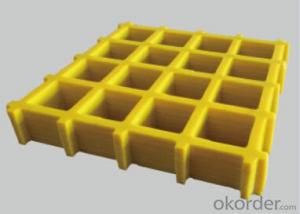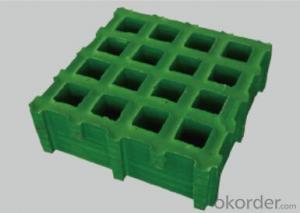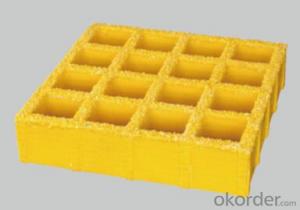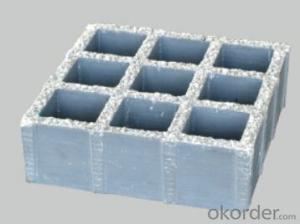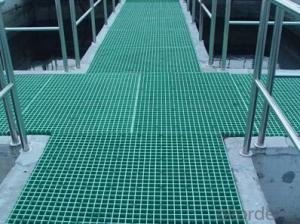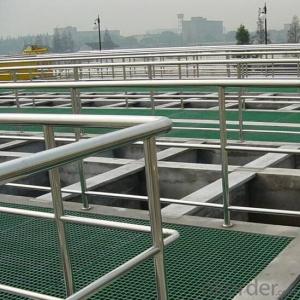FRP grating for sewage pool cover with high quality
- Loading Port:
- Shanghai
- Payment Terms:
- TT OR LC
- Min Order Qty:
- 10 pc
- Supply Capability:
- 8000 pc/month
OKorder Service Pledge
OKorder Financial Service
You Might Also Like
Specification:
FRP molded grating made of vertical and horizontal continuous fiberglass fully soaked in unsaturated polyester resin giving perfect bi-directional mechanical properties. Combining unmatched corrosion resistance with strength, long life and safety, molded grating provide the ultimate in reliable performance, even in the most demanding corrosive conditions. Besides, it is easy to cut and install. CNBM offer the widest selection with panel sizes, colors and slip resistant surfaces, clients can avail FRP grating your specific requirements.
Product Features:
- Light but high loaded strength
- High anti-corrosion and anti-aging
- Easy installation and maintenance
- Low maintenance
- Non-conductive
- Lowest in life cycle cost
- Corrosion Resstance
- Anti-slippery
- Various sizes and color available
Colour Design:
To satisfy customer's design project, CNBM grating offers a wide selection of grating colors to choose from. The standard colors available for fiberglass grating as following:
- Blue
- Red
- Yellow
- Green
- Light Grey
- Dark Grey
Custom colors of fiberglass grating may be available upon request, you can contact us learn more.
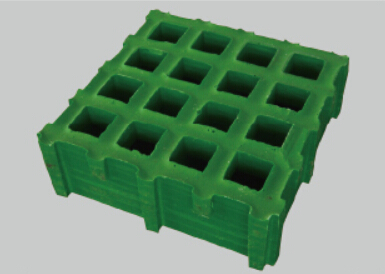

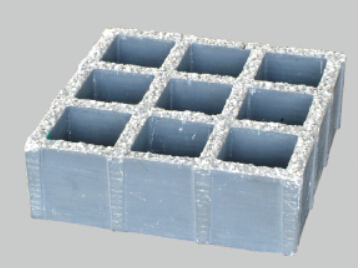

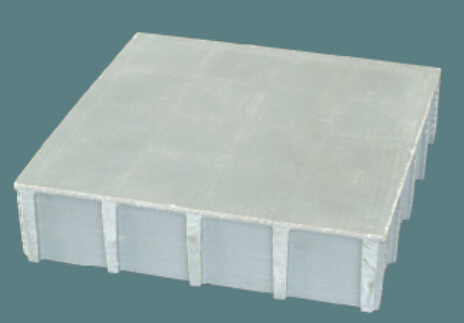

- Q:Are FRP pultrusion profiles resistant to wear or abrasion?
- Yes, FRP pultrusion profiles are highly resistant to wear and abrasion. The combination of strong reinforcing fibers and a durable resin matrix makes them capable of withstanding harsh conditions and maintaining their structural integrity over time, even in high-stress environments. This resistance to wear and abrasion makes FRP pultrusion profiles an excellent choice for applications that require long-lasting and low-maintenance solutions.
- Q:Are FRP pultrusion profiles resistant to chemicals used in chemical plants?
- FRP pultrusion profiles exhibit a general resistance to a wide range of chemicals employed in chemical plants. Their exceptional chemical resistance properties make FRP materials appropriate for diverse industrial applications, including chemical plants. The pultruded FRP profiles are manufactured by saturating reinforcing fibers with a thermosetting resin, such as polyester, vinylester, or epoxy. The selection of these resins is based on their resistance to various chemicals and can be tailored to meet specific requirements. FRP pultrusion profiles have demonstrated their ability to withstand aggressive chemicals, including acids, bases, solvents, and corrosive gases. Most common chemicals found in chemical plants, such as sulfuric acid, hydrochloric acid, nitric acid, and sodium hydroxide, typically do not affect them. Nevertheless, it is important to consider that the resistance of FRP pultrusion profiles may vary depending on the specific resin system, as well as the concentration and temperature of the chemicals involved. To ensure the suitability of the chosen FRP profiles for the chemical environment in a chemical plant, it is always advisable to consult with the manufacturer or supplier.
- Q:Are FRP pultrusion profiles resistant to moisture absorption?
- Yes, FRP pultrusion profiles are highly resistant to moisture absorption. The inherent properties of the fiberglass and resin used in pultrusion manufacturing make the profiles highly durable and impervious to moisture, ensuring long-term performance and minimal structural damage.
- Q:Can FRP pultrusion profiles be used in the production of electrical busbars?
- FRP pultrusion profiles possess exceptional electrical insulation properties, a high strength-to-weight ratio, and resistance to corrosion, making them suitable for the manufacturing of electrical busbars. These profiles excel in electrical insulation, reducing the likelihood of electrical shock and short circuits when compared to conventional metal busbars. Furthermore, their superior strength-to-weight ratio allows for lightweight busbars capable of handling substantial electrical currents without compromising structural integrity. In addition, FRP pultrusion profiles demonstrate exceptional resistance to corrosion and chemicals, making them an ideal choice for harsh environments like chemical plants or outdoor installations. They remain free from rust and degradation, ensuring the longevity and reliability of the electrical busbars. Ultimately, FRP pultrusion profiles offer a cost-effective and efficient solution for the production of electrical busbars, providing improved electrical insulation, strength, and corrosion resistance compared to traditional metal alternatives.
- Q:Can FRP pultrusion profiles be used in telecommunications applications?
- Yes, FRP (Fiber Reinforced Polymer) pultrusion profiles can be used in telecommunications applications. FRP pultrusion profiles offer several advantages that make them suitable for telecommunications infrastructure. Firstly, FRP pultrusion profiles are lightweight yet strong, which makes them ideal for applications such as antenna supports, cable trays, and equipment racks. Their high strength-to-weight ratio allows for easier installation and transportation, while still providing the necessary structural support. Secondly, FRP pultrusion profiles are corrosion resistant, which is a crucial characteristic in telecommunication applications. Telecommunications infrastructure is often exposed to harsh environments, including moisture, chemicals, and extreme temperatures. Unlike traditional materials like steel or wood, FRP does not corrode or degrade in these conditions, ensuring long-term durability and reliability. Additionally, FRP pultrusion profiles offer electrical insulation properties, which is vital in telecommunications applications. They do not conduct electricity, making them safe for use in areas where electrical equipment is installed. This feature helps prevent electrical interference and ensures the integrity of the telecommunication system. Furthermore, FRP pultrusion profiles can be customized to meet specific design requirements. They can be manufactured in various shapes and sizes, allowing for flexibility in designing telecommunication infrastructure. This versatility makes FRP pultrusion profiles suitable for a wide range of applications within the telecommunications industry. In conclusion, FRP pultrusion profiles are well-suited for telecommunications applications due to their lightweight yet strong nature, corrosion resistance, electrical insulation properties, and customization possibilities. These attributes make them a reliable choice for supporting and protecting telecommunication infrastructure.
- Q:Can FRP pultrusion profiles be used in walkway systems?
- Walkway systems can indeed utilize FRP (Fiber Reinforced Polymer) pultrusion profiles. These profiles are renowned for their impressive strength-to-weight ratio, resistance to corrosion, and durability, which makes them an excellent option for various applications, including walkway systems. Due to the lightweight nature of FRP pultrusion profiles, they are easy to handle and install, which ultimately reduces construction time and cost. Moreover, their corrosion resistance ensures that they can endure harsh environmental conditions, such as exposure to moisture, chemicals, and UV radiation, without deteriorating or requiring frequent maintenance. FRP pultrusion profiles can be tailored to meet specific design requirements, enabling the creation of walkway systems with diverse shapes, sizes, and load-bearing capacities. These profiles can be manufactured with anti-slip surfaces or integrated with other safety features to enhance traction and prevent accidents on the walkways. Furthermore, FRP pultrusion profiles possess excellent electrical insulation properties, making them suitable for walkway systems in areas where minimizing electrical conductivity is necessary, such as power plants or electrical substations. All in all, the distinctive properties of FRP pultrusion profiles make them a dependable and versatile material choice for walkway systems. They offer long-lasting performance, low maintenance requirements, and enhanced safety.
- Q:Can FRP pultrusion profiles be used in the construction of elevated walkways?
- Yes, FRP pultrusion profiles can be used in the construction of elevated walkways. FRP (Fiber Reinforced Polymer) pultrusion profiles offer several advantages such as high strength-to-weight ratio, corrosion resistance, and durability, making them suitable for various construction applications including elevated walkways. They are lightweight, yet strong enough to support pedestrian traffic and withstand environmental conditions. Additionally, FRP pultrusion profiles can be easily customized to meet specific design requirements, making them a popular choice in the construction industry.
- Q:What are the different surface finishes available for FRP pultrusion profiles?
- There are several different surface finishes available for FRP (Fiber Reinforced Polymer) pultrusion profiles. These finishes are designed to enhance the aesthetics, durability, and functionality of the profiles. 1. Smooth Finish: This is the most basic surface finish option, where the profile has a smooth and glossy surface. It provides a clean and polished appearance, making it suitable for applications where a sleek and professional look is desired. 2. Textured Finish: Textured finishes add a tactile element to the profile surface, providing increased grip and slip resistance. This type of finish is commonly used in applications where enhanced traction is required, such as walkways, stairs, and ramps. 3. Anti-Skid Finish: Similar to textured finish, anti-skid finishes offer superior slip resistance. They are particularly suitable for areas exposed to wet or slippery conditions, such as marine environments, bridges, and industrial flooring. 4. UV Resistant Finish: FRP pultrusion profiles exposed to outdoor environments are often coated with a UV resistant finish. This type of finish protects the profiles from the damaging effects of sunlight, preventing color fading, degradation, and loss of mechanical properties. 5. Fire Retardant Finish: Fire retardant finishes are used to improve the fire resistance of FRP profiles. They are often required in applications where fire safety is a concern, such as building construction, transportation, and electrical enclosures. 6. Colored Finish: FRP pultrusion profiles can be manufactured with colored finishes to match specific design or branding requirements. This option allows for customization and visual integration with the surrounding environment. It is important to note that the availability of these surface finishes may vary depending on the manufacturer and specific product. Consulting with a FRP pultrusion specialist or supplier can provide more detailed information on the available finishes and their suitability for different applications.
- Q:Can FRP pultrusion profiles be used in the automotive manufacturing industry?
- Certainly! Fiber Reinforced Polymer (FRP) pultrusion profiles have the potential to be utilized within the automotive manufacturing sector. These profiles possess a number of advantages that render them appropriate for automotive applications. To begin with, one of the key benefits of FRP profiles is their lightweight nature, which aids in reducing the overall weight of vehicles. This is of utmost importance in enhancing fuel efficiency and decreasing emissions. Moreover, the reduced weight of FRP profiles enables improved handling and enhanced performance. Additionally, FRP profiles exhibit exceptional mechanical properties, including high strength and stiffness. These properties make them well-suited for integration into structural components of vehicles, such as chassis, body panels, and frames. FRP profiles are able to withstand heavy loads and offer excellent impact resistance, thereby ensuring the safety of both the vehicle and its occupants. Furthermore, FRP profiles possess outstanding corrosion resistance, a quality that is particularly advantageous in automotive applications. In contrast to traditional materials like steel, FRP profiles are impervious to rust and corrosion. Consequently, they are ideally suited for deployment in various automotive environments, including those that involve exposure to moisture, chemicals, and salt. Moreover, FRP pultrusion profiles can be customized to meet specific design requirements, thereby affording flexibility in the manufacturing process. They can be produced in a range of shapes and sizes, which allows for the design of intricate components. This design flexibility also permits customization and optimization of vehicle performance. Lastly, FRP profiles possess excellent thermal and electrical insulation properties. This renders them appropriate for applications where minimizing electrical conductivity or providing thermal insulation is necessary. On the whole, the combination of the lightweight nature, high strength, corrosion resistance, design flexibility, and insulation properties of FRP pultrusion profiles positions them as an ideal choice for deployment within the automotive manufacturing industry. Their usage can contribute to the development of more efficient, safe, and durable vehicles.
- Q:Can FRP pultrusion profiles be used in the construction of solar panel frames?
- FRP pultrusion profiles are a viable option for constructing solar panel frames. These profiles possess qualities such as being lightweight, strong, and corrosion-resistant, making them an ideal material choice. Their durability and high strength-to-weight ratio ensure that the frames can withstand different weather conditions and prolonged exposure to sunlight. Moreover, FRP pultrusion profiles can be easily customized to meet specific design requirements, providing flexibility in solar panel frame construction. All in all, utilizing FRP pultrusion profiles in this industry offers multiple benefits, making it a suitable choice for the solar energy sector.
1. Manufacturer Overview |
|
|---|---|
| Location | |
| Year Established | |
| Annual Output Value | |
| Main Markets | |
| Company Certifications | |
2. Manufacturer Certificates |
|
|---|---|
| a) Certification Name | |
| Range | |
| Reference | |
| Validity Period | |
3. Manufacturer Capability |
|
|---|---|
| a)Trade Capacity | |
| Nearest Port | |
| Export Percentage | |
| No.of Employees in Trade Department | |
| Language Spoken: | |
| b)Factory Information | |
| Factory Size: | |
| No. of Production Lines | |
| Contract Manufacturing | |
| Product Price Range | |
Send your message to us
FRP grating for sewage pool cover with high quality
- Loading Port:
- Shanghai
- Payment Terms:
- TT OR LC
- Min Order Qty:
- 10 pc
- Supply Capability:
- 8000 pc/month
OKorder Service Pledge
OKorder Financial Service
Similar products
New products
Hot products
Related keywords
